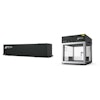MANCHESTER, Conn. (AP) — The eighth and final day of Hanukkah — and eight days of presents — ended Wednesday. But while Jewish shoppers have shot their holiday wad in the ongoing retail extravaganza, they won't stop participating in another retail explosion: kosher foods.
In fact, more and more non-Jews are getting in on the kosher food act. And kosher product producers are responding with a flood of new items to add to the good old traditional ones (like bagels, knishes, blintzes, and matzah ball soup).
I may have seen everything new and old — and tasted quite a few — at the 25th annual Kosherfest in October, a giant two-day trade show at the huge Meadowlands Expo Center in northern New Jersey.
"What a spread!" a grandma could exclaim on surveying the thousands of products in that cavernous space — including pizza cones ("wrapped in genius"), pizza bagels, gelato, Israeli and Australian wines, Local Choice Espresso Vodka, Lime Tequila, and Black Cherry Bourbon), lots of matzah, pasta, meat and poultry sauces, salad dressings, hot chocolate, cakes, cupcakes (Baked By Melissa, the best), really rich pastries and cookies, gluten-free corn flakes, quinoa cereal, quinoa rice cakes, quinoa chips, tortillas, unfiltered real ginger ale, chicken fries, chicken kebabs, zero-calorie Asian noodles, meatballs, fish balls, salami, bologna, cocktail hot dogs, veggie hot dogs, veggie burgers, veggie fish, Italian turkey sausage, olive oils, vinegars, popcorn, and broccoli and spinach pancakes. There's more, but enough is enough.
As Manischewitz Assistant Brand Manager Avital Pessar put it, many of these tasty treats are "like something my grandma would make." That includes wine-maker Manischewitz's new pistachio orange macaroons, farfel (matzah bits)-based granola, new chicken broth, and popcorn.
By the way, it's kosher if it complies with ancient Jewish dietary rules. It's kosher if it's meat from cattle, sheep, and goats, fish with fins and scales, and fruits and vegetables. Not kosher are animals that don't chew their cud or don't have cloven hooves — pigs, camels, rock badgers, and rabbits (I'm not kidding) — and lobsters, oysters, clams, crabs, and shrimp. Also, meat and dairy products can't be made or eaten together.
To illustrate market growth, when Menachem Lubinsky started Kosherfest in 1988 it featured 30,000 products from 69 companies and 700 visitors. This year 275 companies exhibited 175,000 products. More than 6,500 industry professionals attended, with 28 percent more buyers than in 2012, including high-volume kosher buyers from Whole Foods, Walmart, and Walgreens. Exhibitors came from as far away as Argentina, London, Israel, and Mexico City and from many states beyond the Northeast, including Texas, California, and Florida.
And who's buying is a surprise. "Almost two thirds of kosher consumers are not Jewish, including other religious groups such as Muslims (16 percent), and a growing number of Americans who believe kosher is better and healthier," Lubinsky said.
Here are data compiled this year by Lubicom Marketing Consulting:
. Annual growth from 2008: 10 percent.
. 12,250,000 kosher consumers in the U.S.
. 21 percent of Americans regularly or occasionally buy kosher, 55 percent of those for health and safety, 38 percent because they're vegetarians.
. 3.5 million Muslims and members of other religions eat kosher products.
. Value of U.S. kosher goods: $305 billion.
. Number of kosher-products: 190,000.
. Kosher products in U.S. supermarkets: 19,000 on average.
"The U.S. is a developing market for kosher wines. You see it growing every year," said Amotz Teperbeg, export manager and sixth-generation partner in Israel's Teperberg Winery, selling 6 million cases a year. "Today almost 60 percent of Israeli wines go to the U.S., their biggest market."
"I've been asked over and over again to do a kosher gelato," said Giuliana Mirabella, owner of a New Haven gelato company, who launched her first kosher gelato at Kosherfest. "We're going to make it in 40 flavors — mocha, pistachio, caramel, passion fruit, chocolate, endless flavors, strawberry, cinnamon bun, maple syrup, mango, endless flavors."
Kosher Passion Fruit was a winner. Mirabella's non-kosher gelato is already in major Connecticut supermarkets.
Even Streit's Matzo Co., opened in 1925, the oldest matzo (or matzah) bakery in the U.S., has come out with new products. It's now offering quinoa and gluten-free matzah balls to go along with other items and 30,000 pounds of matzah it sells daily.
"The kosher market is also growing in Mexico," said Jacopo Sacao of Mexico City's Sinai Deli and Bakery, who exhibited his breads. "In Mexico we have 60,000 Jewish people, and maybe 20,000 are kosher. A lot of people are getting kosher in Mexico City. They're coming back to their religion."
Among the new companies at Kosherfest was Cuppa J, with gluten-free, lactose-free (and delicious) Double Dark, Maryam Spice, and Mystic Mint hot chocolate.
"I always liked hot chocolate," said Cuppa J founder Jacob Hill. "My nieces and nephews are lactose-intolerant, as I was as a little kid, so I made this, since they never had hot chocolate before."
Another intriguing new product was California-based Miracle Noodle's Asian noodles — made from plant root fiber (3 percent) and water (97 percent).
"We chop the root of a plant into fine pieces and mill it into a flour," co-owner Jill Goldstein explained. "Then it's boiled at a high temperature and chilled, and we cut it into the different-shaped noodles." They're gluten-free, soy-free, wheat-free, have no calories, and they were really good, good news for a pasta lover . and diabetics.
One new product I took a shine to was reusable dreidel (the four-sided top)-shaped plastic ice cube containers. I took home a dozen, put them in the freezer, and popped them in family members' cold drinks. Were they impressed? Not really.
But the chocolates? Oy!






















